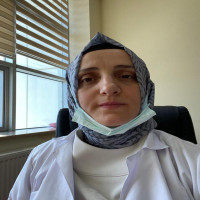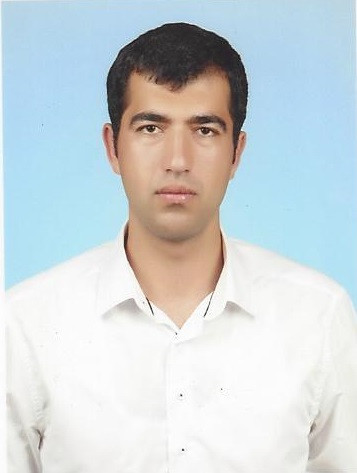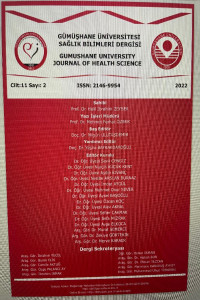Original Article
Derlemeler
Issue Editorial Board


 0000-0003-1163-4829
0000-0003-1163-4829




 0000-0002-0840-7134
0000-0002-0840-7134
 0000-0003-1460-4780
0000-0003-1460-4780


 0000-0003-1666-6109
0000-0003-1666-6109



 0000-0002-3751-131X
0000-0002-3751-131X
Aim & Scope
Gümüşhane University Journal of Health Sciences; scientific writings in health fields such as Medical Sciences, Nursing, Midwifery, Nutrition and Dietetics, Health Management, Social Services, Occupational Health and Safety, Emergency Aid and Disaster Management, Sports and Health, Child Development, First and Emergency Aid (Paramedics), Medical Laboratory It is a peer-reviewed journal.
Medical Sciences, Nursing, Midwifery, Nutrition and Dietetics, Health Management, Social Services, Occupational Health and Safety, Emergency Aid and Disaster Management, Sports and Health, Child Development, First and Emergency Aid (Paramedic), in Gümüşhane University Journal of Health Sciences, articles with the following characteristics related to medical laboratory titles can be published:
*Review: A comprehensive review of recent scientific studies on a particular subject,
**Research Article: An article in scientific format that introduces original research and presents its results,
***Case report: There are different case studies according to the society.
The journal is published four times a year.
Manuscripts that have been previously published in the journal, accepted for publication and are being evaluated for publication are not taken into consideration.
Submission of articles to the journal can only be done through Dergipark.
If a correction is requested from the author, the correction must be made within 1 month at the latest.
The responsibility of the published articles belongs entirely to the author(s).
Writing Rules
* Articles written in either Turkish or English languages are published in our journal.
*It is recommended to use the article template on our web page while the author is writing the article.
* Manuscripts specified in the article template should be written in Word 2003 or higher versions, in A4 size, “Times New Roman” font style, main text in 12 points and single line spacing, justified on both sides and in two columns. An article is sent to the journal with a .doc extension.
The first line indent in paragraphs should be 0.5 cm. Before and after the paragraph, there should be 6 pt space between them, there should not be too much space between the blank lines and texts.
Turkish title: It should be written in 12 point bold with the first letter of each word being capitalized.
English title: The first letter of each word should be capitalized, and it should be written in normal 10 pt.
*Explanations required for this study, if any, should be written (…presented as … in congress/symposium, thesis or project work, received from the University … board, supported by Research Project (Project No) etc.) or acknowledgment text
1 Title, Author's Name SURNAME, Profession, Institution and Department, e-mail, ORCID:XXXX-XXXX-XXXX-XXX
2 Assoc. Dr., Author Name SURNAME, Public Health, Gumushane University Faculty of Health Sciences, Department of Health Management, e-mail, ORCID:XXXX-XXXX-XXXX-XXXX
Corresponding Author: Name SURNAME
Received: 00.00.2021
e-mail: xxxxxx@xxxxxmail
Accepted: 00.00.2021
1.Example Author Footer
Names of the authors, as indicated in the 1st sample author footer: Name and Surname should be written under the English title and side by side. The names of the authors after the title should be written before using the title, the name starting with a capital letter, then the surname in all capital letters. At the end of the authors' names, a number should be placed in the form of a superscript and in the table template field at the bottom of the page, in accordance with these numbers, the authors' academic title, field of specialization and institution, ORCID information should be written in 8 points. In italics at the top of the author's information: if the research was presented as a paper (oral or poster) at a scientific meeting, or if the thesis is a thesis, it should be stated with the date and place as shown in the template at the bottom of the title page of the article. Project number can be added. Acknowledgments may be included in this field.
Article titles:
"In English articles, the abstract part (on the left of the page) is written before the abstract (on the right of the page)"
RESEARCH: SUMMARY«ABSTRACT, INTRODUCTION, MATERIAL AND METHOD, FINDINGS AND DISCUSSION, CONCLUSION AND RECOMMENDATIONS, REFERENCES
REVIEW: ABSTRACT«ABSTRACT, INTRODUCTION, Subtitles related to the subject, CONCLUSION AND SUGGESTIONS, REFERENCES
SYSTEMATIC REVIEW: SUMMARY«ABSTRACT, INTRODUCTION, METHOD, FINDINGS AND DISCUSSION, CONCLUSION AND RECOMMENDATIONS, REFERENCES
CASE REPORT: SUMMARY ABSTRACT, INTRODUCTION, MATERIALS AND METHOD: (Data Collection-Case Report), FINDINGS AND DISCUSSION, CONCLUSION AND RECOMMENDATIONS, REFERENCES
Main titles should be written in single column width, centered on the page and in Bold CAPITAL letters.
Abstracts: They should be written in 10 points size and should not exceed 250 words. The abstract should not contain equations, citations, non-standard abbreviations. Subheadings in summary paragraphs should not be added to the summary. The abbreviations used in the manuscripts should be written clearly when they are first used in the text and the abbreviated form should be given in parentheses next to it. Headings should not be numbered and should be written in all capital letters and in bold, aligned with the beginning of the paragraph.
Keywords; It should be compatible with IndexMedicus:Medical Subject Headings (https://www.nlm.nih.gov/mesh/MBrowser.html) and Turkish Science Terms dictionary.
“INTRODUCTION” section should start from the second page and the last paragraph should include the purpose of the article.
It should be noted that the text, drawings or graphics are within the writing area. Page margins in articles; top and left should be 2.5 cm, bottom and right should be 2 cm.
Manuscripts should not exceed 25 pages, including figures and tables.
The number of tables and figures should not exceed 5 in total.
Pictures, figures and graphics in the articles should be displayed under the name of "Figure"; Figures and graphics should be drawn in computer environment. Tables, figures and equations should be numbered, the titles should be written above the tables and below the figures, with the first letter of each word capitalized.
Tables; should be placed in the appropriate place in the text, decimal numbers should be separated by commas, not periods (except for the English abstract). Tables should be made using the table menu, cells should not contain more than one value, alignment should not be done with the space bar, should be done with the help of a ruler, numbers should be right-justified and the number of tables should not exceed 5. Titles should be written in 10 points, Table Content should be written in 8-10 points, References should be written in 8 points. Subsequent tables and figures should not be shown in the article.
The abbreviations used should be stated in the explanation below the figures, pictures, tables and graphics. If previously printed figures, pictures, tables and graphics are used, written permission should be obtained and this permission should be stated in the description of the figure, picture, table and graphic and should be cited as the reference.
Authors can only cite the references they directly benefit from in their articles. Our journal does not deem it appropriate to use the references reported in other studies in the form of citation.
References of numbers; In the text or at the end of the sentence, it should be written as superscript1 after the period.
The number of references should not be more than 40 in total in articles and 65 in reviews.
References should be listed in the order in which they are used in the article. When writing more than one reference number, a space should be left after the comma, and if more than two consecutive reference numbers are to be written, a “-” sign should be placed between the first number and the last number. References should only be at the end of the sentence. As a reference; Unpublished reference (unpublished congress, symposium, meeting, etc. documents) cannot be used.
References are similar to apa style, bibliography writing style is included as an example in the article template, care should be taken not to abbreviate a study with multiple authors with a single author name and to indicate the beginning and end of the reference pages. The abbreviations to be used should be in accordance with Index Medicus.
In the manuscripts reporting the results of experimental studies conducted on humans, after the characteristics of the procedures to be applied to the volunteers or patients in which this study was conducted, a sentence indicating that they were informed and their consent was obtained should be included in the "Ethical Aspect of the Study" sub-title in the Material Method. Authors should submit the approval they have received from the relevant Ethics Committee in the case of such a study. In case reports, information about signing the informed consent/consent form should be included in the article. Relevant ethical approval should also be obtained for studies performed on animals. When a photograph is used to promote patient identification, the patient's written consent should be obtained and the patient's eyes should be covered with tape. When a photograph belonging to a private institution such as an institution is used, the written permission should be stated in the article and the permission information should be sent to us. For the use of scales, questionnaires and photographs belonging to others, permission should be obtained from the owners and should be stated in this study. The photograph information used should be explained with the “Picture X.“ symbol.
In the material and method section of the article, the organizations supporting the work, the number of the project work, the ethics committee report and the institution and dates from which permission was obtained should be written. It is also indicated in italics above the author information on the first page.
The plagiarism rate measured by us during the pre-control phase of your article should be 20% or less.
To check the spelling rule for the author, the author must fill in the checklist, and all the steps in the article author checklist must be compatible with the "Yes" option.
The publication copyright transfer certificate and the ethics committee and the Institution's permission certificate, if any, should be sent as an additional file together with the article submission.
Works that do not comply with the above format will not be evaluated in terms of content and will be returned to the author by the editor.
That’s why; Before sending your article to our journal, check it one last time according to the "Author's Checklist". The article template will provide convenience to the author about the writing style.
Ethical Principles and Publication Policy
"Committee on Publication Ethics (COPE)" on the publication ethical policy criteria; guides our writers, editors and consultants.
For the year 2020, from the article writers in the articles of entrepreneurial research quality and in the interviews and survey studies; For research that requires data collection by means of scales, questionnaires, interviews, observations, stating and documenting the ethics committee approval (name, decision date and number) of the candidate article and in the method section, Information regarding the signing of the informed consent form. It is requested to include in the article, to present the proofs of the ethical principles in the data collection process (such as obtaining permission for the use of scales, questionnaires, documents from others, and transmitting the permission information to the journal), to indicate that research and publication ethics are followed in the articles. *Ethics committee approval must be obtained separately for research conducted in all branches of science, including social sciences, and for clinical and experimental studies on humans and animals that require an ethics committee decision, this approval should be stated and documented in the article. Information about ethical rules should be given to the editor under separate headings. *A statement about compliance with Research and Publication Ethics should be included in the articles. *In case reports, information about signing the informed consent/consent form should be included in the article. For detailed information: TR Index Criteria
Regarding the published publications whose copyright is given to our journal, the author cannot request the copyright permission from the journal again in order to publish it in another book.
In the article submission process, the article sent by the author to the sample article template format on the home page of our journal must be adapted.
The article must not have been previously published as a journal, book or full-text paper.
Copyright information, in research articles that require ethics committee approval (including retrospective studies); Ethics committee permission information in the material and method section, limitations of the study (if any), supporting institution information (if any), scale permission information (if necessary) should be submitted to our journal as an additional file.
If the ethical permission, institutional permission or consent information is not clearly stated (if necessary, ethical committee and institution permission information can be requested from case reports), the relevant article will not be accepted for the pre-control process if the permission information is not attached as a file in the article file area.
Ethics committee permission information should be compatible with article title and author information.
The plagiarism value of the article sent by the author is checked by us. As a journal publication policy, the plagiarism value of the article should be 20% or less in preflight. (It will be beneficial for the author to check the plagiarism value before submitting the article.) If the plagiarism information is high, the report is presented to the author by the journal.
It is important that the author write a sentence or two stating the original value of the article to the editor in the note field during submission.
If it is thought that there are deficiencies in material, data collection, ethics, institutional permission, statistical steps in the method, the article can be rejected by informing the author during the article evaluation processes.
It is important for the author to make an explanation on the author's information on the first page of the article regarding ethical permission, explanation if it is the thesis topic, oral presentation, poster presentation and/or thesis articles.
Full-text papers with the same material method are not accepted as articles in the journal publication process, the editor may request additional file information from the author for the abstract pages.
In our journal, double-blind refereeing is done for the selection of referees in the referee process.
Price Policy
No fee is paid for articles published in the journal.

